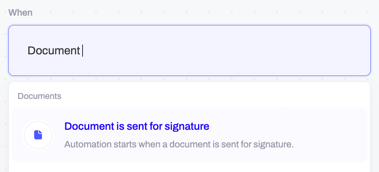This article will explore how to base automation actions on the "document is sent for signature" trigger event.
It contains the following topics:
- Using the "document is sent for signature" automation trigger
- Configuring the automation trigger
- Deleting an automation trigger
- Configuring the automation action
- Deleting an automation action
- Renaming the automation
- Making changes to published automations
- Using the automation activity feed
- Testing the automation workflow
- Fixing a failed automation
- Checking a successfully run automation
How to automatically add pending contracts to the correct shared folder?
For example, we will show you how to add a pending contract to the relevant shared folder automatically.
With the in-app automation builder, you can automate this or any other process (based on a different automation action), ensuring that your pending contracts are kept in order and accessible to the right collaborators.
Here is a short video tutorial of the needed for the automation setup steps, and a step-by-step guide will follow right after:
- Click on Automations tab from the main menu and then on the blue button Create new at the upper right-hand corner.
- You will be redirected to a pop-up window where you can customize the automation's setup.
How can I configure the trigger event?
- The first thing you need to do is to set the trigger event which must occur for the automation to be executed.
- To specify that the pending state of the contract has to start the automation, you have to select the Document is sent for signature trigger from the drop-down menu:

- This will automatically open a configuration window to the right in which you can define which contract should start the automation.
- You can assign the trigger to any document in general, any document drafted from a specific template, or only a particular document sent for signature.
- For the most efficient automation flow, we recommend using Any document drafted from a specific template.
- This will allow you to automatically add a pending contract created from a specific template to a shared folder:

- After selecting one of the three main options, you can use the search bar to find the particular contract, draft, or template you want to base the automation flow on by name.
- If you have several documents sharing the same name, you can click on the small eye icon, and this will directly open the particular document for your review:

- After choosing the correct file, confirm by clicking Save, and the next step in the automation setup will be displayed.
How can I delete the trigger in the Automation Builder?
- At the bottom of each trigger configuration window, you have the option to delete only this specific trigger and not the complete automation:

How can I configure the action event?
- This adjustment step covers the action the automation trigger you have just defined will generate.
- You can use the search bar to locate the option Add to a shared folder.
- The first detail in the action step of the automation configuration is the Document ID of the template, which will be used to execute the automation.
- It will be automatically fetched and available under the respective required field under the Add to a shared folder window:

- The next step is to select which specific shared folder you want to use for the automated workflow.
- Use the search bar to locate the correct folder by name, and remember it has to be already created:

Once you have completed these steps, click Save to confirm the configuration of the automation flow and then Publish in the upper right-hand corner.
How can I delete action in the Automation Builder?
At the bottom of each action configuration window, you have the option to delete only this specific action and not the complete automation:

How can I rename the automation?
You can always rename the automation and its steps as you find fit by clicking on the small pen icon next to the generic title in the upper left-hand corner.
In the example we are working with, we will call it "Add to Sent for signature Sales folder":

How can I make changes to published automation?
Note: If at one point you need to make any changes to the automation configuration, remember to unpublish the automation first, then make the necessary modifications and click again on Publish to put the workflow into use.
You can control that by turning the Status toggle bar on or off:

How can I use the Activity feed of my automation?
- If you click on the three grey dots next to the status toggle bar, you can open, rename, duplicate, delete, or see the activity feed of the automation.
- Remember that the automation must be active (published) for the activities to be available to view. This option allows you full traceability of the automation's usage and flow:

- In the activity sidebar, you will be able to see all the details of when the automation was used and the steps taken before it was triggered.
- Just click on the small arrow next to the date and time to expand the details:

- In addition, you will always be notified in-app in the Notifications at the top navigation bar as soon as any of your automation flows has been executed:

Note: You can adjust your account's email and in-app notifications under Profile Settings.
How can I test the published automation?
- For the test to be performed, you need to save the template you have selected as a new draft and turn it into a pending contract by sending it to any external Signee for a signature.
- As soon as the document has been sent for signature, you can go back to your documents overview and check the Notifications under your account.
- The automation status will be listed there as either successful or failed.
How can I fix a failed automation?
- If the automation fails, you can access the detailed view by clicking on the failed notification in the list.
- In this view, you can identify the reason for the failure by expanding the failure to run details. You can use the information found here to change the automation from the configuration settings.
How can I check the automation runs successfully?
In case your automation has run successfully, you can then open the shared folder by clicking on its name in the activity sidebar view, and the new pending contract created from the template you have defined in the automation flow will be located at the top of the documents list in the folder:

Now that you have tested the automation workflow, you are ready to start using it actively and save time by automatically adding pending contracts to the relevant shared folder.
With our in-app automation builder, you ensure you always have your documents organized and shared with the relevant parties.
Note: Automated workflows and integrations are available for the users on any of our paid subscriptions.
You can find more automated workflows you can tailor to your needs with our in-app automation builder here.
If you need additional information or assistance, contact us anytime via our Online Support Chat or email.
